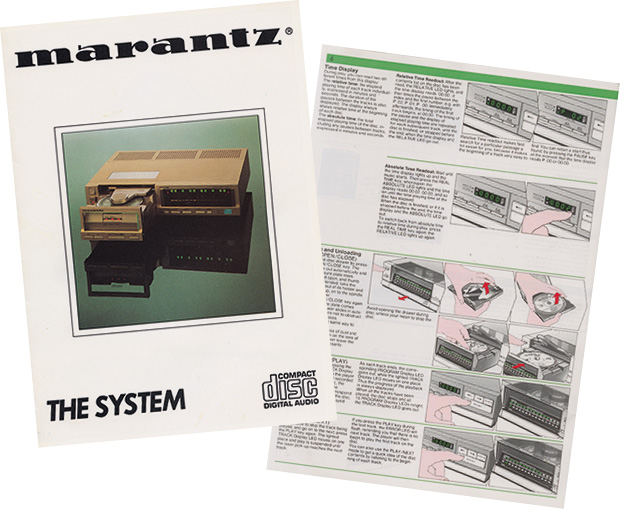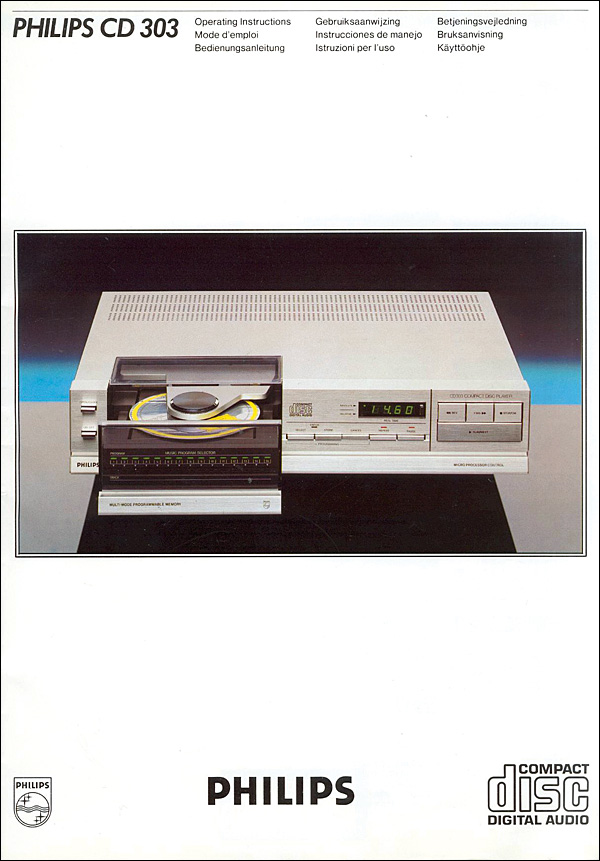Marantz CD-73 CD player

 Glitsy looks and a lack of niceties such as time display, but this version of the Philips CD300 CD player was first to market where it became king of the 14-bit machines
Glitsy looks and a lack of niceties such as time display, but this version of the Philips CD300 CD player was first to market where it became king of the 14-bit machines
The CD-73 is surely one of the best loved and best remembered of the first generation of CD players. With its eye-catching looks, it stood out among a sea of bland black boxes. Usually it would have been difficult for a company of Marantz's standing to come up with a fully engineered model so quickly, but having recently secured the backing of Philips, it was able to release not one but two class-leading CD players for the opening 1983 season.
One was the CD-63, an unmodified Philips CD100 [HFN Oct '11] sporting a gold anodised finish with Marantz scripting. The other was the CD-73. Although still a Philips player made in a Belgian Philips factory, this machine had more of a Marantz identity.

Statement Piece
The player was shown in prototype form during the previous year as the CD-83, but Marantz had been quicker to get its version to market while the Philips variant, the CD300, took a little longer. The CD300 was soon replaced by the CD303 [HFN Nov '13], which was essentially the same machine but with a digital track-time readout. This refinement was never applied to the CD-73, which right to the end retained its prominent strips of green and orange LEDs as its only form of track indication.

As much as the CD300 and CD303 had been examples of European design elegance, so the CD-73 was brash and busy in the best Japanese tradition. A riot of polished metal, flashing lights and stylised legends, the model could certainly be called a statement piece. Highlights included a vivid blue illuminated 'Compact Disc' logo and an indicator on the sliding tray marked 'Laser' – two motifs to herald the new era. As with the CD300 and the CD303, a form of front-loading was achieved by mounting the complete optical deck on a sliding platform that was driven out from the player's fascia when requested by motor power.
Green Machine
The clamping arm for the disc was operated automatically by the same mechanism, so loading was especially straightforward, while a series of interlock devices prevented the player from being used unless the 'drawer' was shut. Also common between the two brand offerings was the set of six LEDs that bathed the disc being played in green light as it spun.

Despite being almost certainly a styling gimmick, these LEDs did predict the brief craze for marking the edges of CDs with green ink (in the pursuit of improved performance) about ten years later.
Japanese Sourced
Although the optical unit and main printed circuit boards were nominally identical between the Philips and Marantz versions of the machine there were some notable differences when it came to the rest of the build. The CD-73 made use of Japanese-sourced wiring materials and connectors in its supporting circuitry and even some of the larger components, such as the mains transformer, were sourced from Japan.
This was in contrast to the CD300 and CD303, which were made almost entirely in-house by Philips. The CD-73 also had detachable mains and signal cables, the sockets for the latter being gold-plated, while provision was made for remote control, using a link-up system common to other components in the Marantz range of the time. The RC-430 infrared receiver was the key unit here, which was large enough for the CD-73 to stand on. The CD-73 also has an extra box attached to its rear panel that's absent on the CD303. This houses a mains filter. The filter is present in the CD303, but mounted elsewhere.
Like all early Philips players, the CD-73 made use of 14-bit architecture and 4x oversampling in its DAC. The loss of resolution implied by not directly converting the two least significant bits of the music data was addressed by adding three carefully calculated points between each recorded sample, restoring the amplitude resolution of the system.

In addition, it was argued that this arrangement was potentially more accurate than a linear 16-bit converter, on the basis that it is difficult to make the gaps between each digital 'step' exactly consistent at fine levels of detail. Although controversial (both then and now), the Philips-based machines that used this technique were widely regarded as being the best performing of the early generations of CD players.
Of the Philips family, Marantz was often credited with having a small lead in sound quality terms, despite being identical to the other machines in all key areas. This was probably a result of the Marantz range containing better supporting equipment, enabling more effective demonstrations of the player's capabilities.
In the early 1980s, a CD player's error correcting chip was said to be the most intricately made part. Not surprisingly, this led to production difficulties for the Philips SAA7020 and SAA7000 integrated circuits, both key components in all its early players. The solution was to modify one of the circuit boards in the player to accept available parts, in this case the Sony CX7933, CX7934 and CX7935 chipsets as used in the Sony CDP-101 [HFN Jan '12] and CDP-11S and the UK version of the latter – the Ferguson CD 01 [HFN Jan '19].
Maze Of Mods
The modifications were extensive and included a complex maze of interfacing parts, along with the Japanese components mounted on a plug-in sub panel. Model numbers remained unchanged, so it was impossible to tell externally which version you had. This change can be found in any Philips-made player before the CD104, but is most regularly encountered in the Marantz CD-73 (including our review sample). By contrast, the CD303 tested in HFN Nov '13 used the full Philips chipset.























































